Effects of gemstones
Gemstone Special Effects (SFX)
"To suppose that the eye... could have been formed by natural selection, seems, I freely confess, absurd in the highest degree."Charles Darwin (1809-1882), Origin of Species
Gemstones, jewels, bijous, rocks, and 'bling' are much more than just dazzling, multicoloured expensive minerals and organics. Some gemstones also have special optical effects or simply 'SFX'. Called 'phenomena' by gemmologists, these rare and beautiful optical properties are part of a gemstone's structure. Frequently adding value, expert gem cutting can bring out these unique effects to their fullest, or hide them when necessary.
Adularescence (Opalescence)
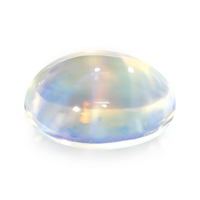
Rainbow Moonstone showing its characteristic blue adularescence
Adularescence mightn't be the easiest word to remember, but it is very easy to spot. Remember 'Moon Shadow' by Cat Stevens? Adularescence is the silver to bluish-white light that shimmers and glides over the surface of that enchantingly romantic gem, Moonstone. Adularescence is due to 'interference phenomena', which simply means the scattering of light by thin crystalline layers. This effect gets its name from a variety of Moonstone found in the European Alps called 'Adularia', and is called 'opalescence' when occurring in Opals.
Asterism
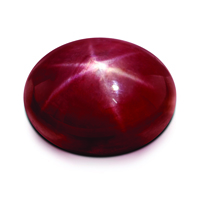
Star Ruby, once aptly known as the 'three swords'
Asterism, also known as the star effect or asteria, is a uniquely beautiful, mysterious optical effect especially coveted in Rubies and Sapphires. Asterism is created by the reflection of light from multidirectional, long needle-shaped inclusions that occur in parallel arrangements in at least two different directions. While they come in six rays, four rays, and on the odd occasion 12 rays, all star gems are dependent on a gem being cut 'en cabochon' (cut in convex form and highly polished, but not faceted). Asterism is most visible in a direct, single beam of light. Colour aside, a well cut star gemstone has a distinct star whose rays are straight and equidistant. Stars are typically positioned in the centre of the gem, bearing in mind that they are sometimes deliberately off-centred for aesthetics.
Aventurescence
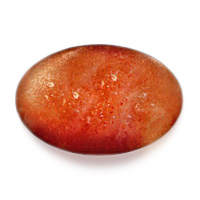
Madagascan Sunstone
This one originated in an 18th-century Venetian glassworks, when copper filings accidentally fell into a batch of molten glass. According to legend, the workers exclaimed, "a ventura", which means 'by chance', on noticing their glass with sparkles. In gemstones this phenomenon is caused by glittering metallic inclusions. In Chalcedony Quartz, thousands of tiny metallic flakes create the glimmering rarity called Aventurine and when present in Feldspar, sparkling Sunstone. One 'gem' to be aware of is Goldstone, a manmade glass and copper substitute.
Chatoyancy
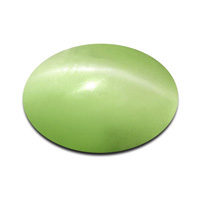
Cat's Eye Chrysoberyl
French for cat, le chat is obviously all about our feline friend. Chatoyancy, also known as the cat's eye effect, appears as a single bright reflective line of light, similar to a cat's eye. Chatoyancy is created by the reflection of light from long needle-shaped inclusions occurring in a parallel arrangement. Similar to star gems, the cat's eye effect is dependent on a gem being cut 'en cabochon' and is most visible in a direct, single beam of light. One gem synonymous with this phenomenon is Chrysoberyl, so much so that that if you just say 'cat's eye' to a gem professional, they'll assume you mean Cat's Eye Chrysoberyl.
Colour Change
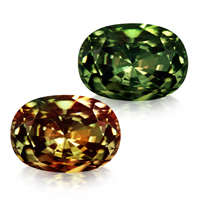
Brazilian Alexandrite showing its colour change
Gemstones that display this phenomenon include the miraculous Alexandrite, which can appear blue-green, teal or yellowish-green in candescent light (sunlight), and brownish-red, orangey-red or reddish-purple in incandescent light (candlelight). Also know as the 'Alexandrite Effect', colour change gems show different colours when viewed in two different light sources. Although they appear similar to our eyes, sunlight has very strong blue wavelengths, while electric light is richer in red wavelengths. In colour change gems, absorption of different colours of the spectrum from different light sources results in our 'colour change' perception. Other colour change gems include Colour Change Garnet, Colour Change Sapphire and Zultanite. A colour change gem is rated by the strength of its change, and how attractive and distinct its colour is in both candescent and incandescent light.
Iridescence
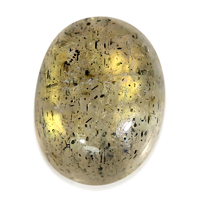
Labradorite displaying its signature metallic iridescence
Derived from the Greek 'iris', meaning 'rainbow', iridescence is a rainbow-like colour effect caused by a gem's structure breaking up light into its spectral colours. With colours that change depending on the angle of observation, some everyday examples of iridescence are soap bubbles and butterfly wings. The 'metallic iridescence' or 'schiller' in Labradorite it aptly called 'labradorescence', while the delicate iridescence seen in Pearls is called the 'orient' or 'overtone'. Examples of other iridescent gems are Ammolite, Fire Agate and Mother of Pearl.
Play of Colour
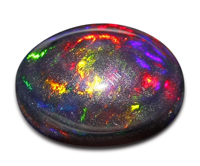
Play of colour in Mezezo Opal
Do you remember science class with the prism that displays the spectral colours of the rainbow? If yes, you already understand play of colour. Unique to Opal, 'play of colour' is the flashes of colour that change with the angle of observation. An Opal, whose 'play of colour' flashes are in the rare reds, is generally more valuable than Opals with just blue and green, but as with all gemstones, colour preferences are subjective and should be dictated by individual tastes.
Pleochroism (Double Refraction)
In certain gemstones, atoms are arranged so that light splits into two separate components. If this results in optical doubling, then this is called 'double refractivity' or 'birefringence'. Zircon is a good example of a doubly refractive gemstone. If these rays of light possess different colours visible when the gem is viewed from different angles, then this is called 'pleochroism' or getting more technical, dichroism (two-colours, such as Tourmaline) and trichroism (three-colours, such as Tanzanite).
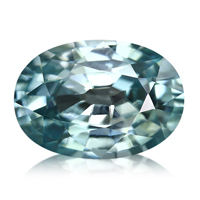
Ratanakiri Zircon is a doubly refractive gemstone
A common misconception is that double refractivity makes a gem more brilliant. It doesn't. In fact, singly refractive gems can display colours that are purer and more intense than those seen in doubly refractive gems of the same colour (e.g. Noble Red Spinel versus Ruby). Confused? The word that causes the problem is 'double'. While light is being split into two (doubled), the amount of light exiting the gem is not.
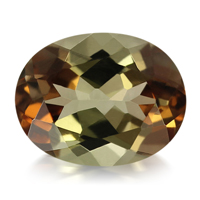
Andalusite displaying its pleochroic colours
While pleochroism can create unique colours in gemstones, sometimes adding richness, it affects gem buyers in three ways: the component colours are so similar that pleochroism usually doesn't negatively affect beauty (e.g. Ruby and Sapphire); the component colours are different and not all are attractive, so cutters minimise pleochroism by orientating the crystal to display its single best colour (e.g. Kunzite and Tanzanite); or the component colours are different, yet attractive, so the cutters orient the gem to get a pleasing mix of colours (e.g. Andalusite and Blue Green Tourmaline).



